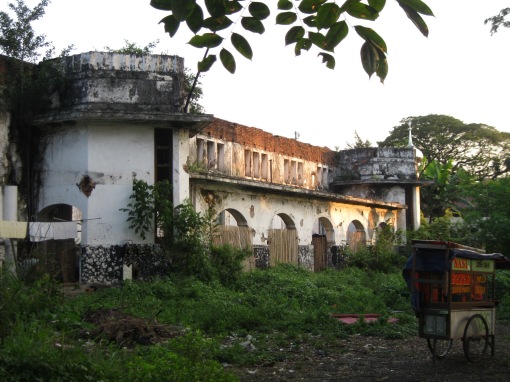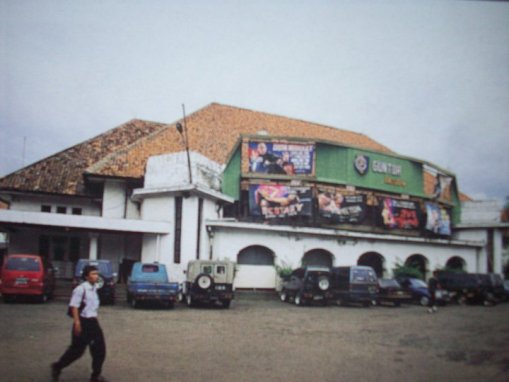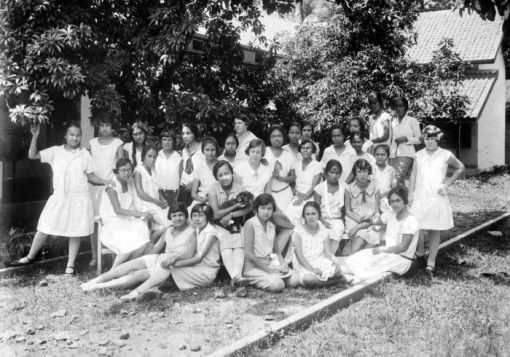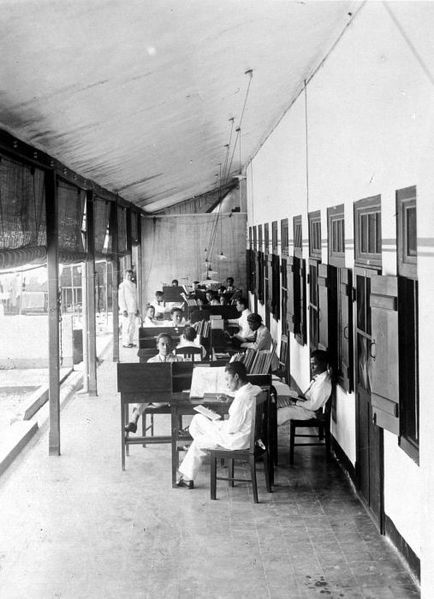I snapped the “now” shot a few months ago, a few blocks from the Sharehouse.
It’s the historic Guntur theater (same link but in Indonesian). The Indies Art Deco building designed by Ir. FJL. Chijsels (of AIA Bureau) was built from 1923-27. The flood canal (from the waterworks in Manggarai) had just been completed. So this would have been a prominent country crossroads (Jl. JP Coenweg and Jl. Goentoer) .
Meanwhile, the black-and-white “then” photo is an old postcard belonging to Tokek Belanda on Flickr. The structure has deteriorated rapidly. I did a double take after seeing it on Flickr. I could access my own “geo-stamped” memories of it after more than five years transiting Jl Guntur. But I couldn’t find it — or see it, rather — when I rocked up to where it was supposed to be. Turns out that, as it crumbles, less and less is visible from the street. 
Long before this was the movies, it housed the Jan Pieterszoon Foundation (Stitchting) — and a boarding school. We don’t hear much about JP these days, but he’d be shocked by the photo of women (below) in full multicultural mingle mode.
During WWII the Dutch used the property for military purposes, as does the police or “MP” branch of the Indonesian armed forces today.
But there’s a couple mysteries. So please COMMENT BELOW if you know: Was the theater famous or just the old building? Was it in fact a rowdy place where drinking was allowed? Also, scarier then or now?
The Guntur area is still sometimes referred to as Manggarai, although it doesn’t make sense it terms of today’s Jakarta map.
But let’s say you’re a Djakarta kid and school’s out. That means it’s a good time to catch a flick at Guntur, swim at the gym in Manggarai, or shop for a horse at “Grass Market” (Pasar Rumput). Getting there, we leave Weltevreden (now Menteng) and head toward Manggarai which is in Meester Cornelius, a different municipality, crossing the flood canal/Ciliwung river on the Guntur Street Bridge. And now we’re in the countryside, surrounded by leafy country estates and productive land. As for hay and horse traders, I understand you could find them at Pasar Rumput into the 1970’s, when they were replaced by shifty types hawking bicycles and other recreational equipment (the maid said “give me a break don’t we all know a calo (tout) when we see one — they’re black as raisins for crying out loud.” )
Halimun (once “Nieuw Menteng”), where the Sharehouse is located, is an adjacent residential area on the other side of Perahu Tangkuban Park from Jl Guntur. I’m told this is where the workers who were laying out Menteng lived. In fact, it kind of looks like Menteng, but on a smaller scale. A recently disappeared 1870 mosque (Mesjid Perahu Tangkuban) stood next to the park between 2011 and 1908 , the year it was relocated to from another part of Menteng.
As far as the old postcard, today there are actually several older structures in the complex pictured, including the MP offices and barracks. The theater was one of two twin buildings, but I’d have to ask Ibu Murni, the old, blind massage lady, for more details. She knows her away around in there.
The color photo was shot from a tree and across the fence. You could try standing on the Menteng side of the canal with a long lens, too.
JP Foundation’s boarding school touted itself as (paraphrase):
Located in New Menteng, the southernmost, highest and most healthy part of Weltevreden. Those wishing to to take a look at the buildings are welcome, provided notice of the visit is provided in advance. Requests should be addressed to the director at Goentoerweg No. 1
I guess Guntur, Haliumn, Tangkuban Perahu, and most of the other streets in the area carry their original names (prominent Javanese mountains/inactive volcanoes). However, the Dutch spelling was different in most cases.
There are a few books about Ir. FJL. Chijsels and his work. He built what is now the Bappenas building (once a Masonic lodge) at Taman Suropati and the Catholic church across the street from it.




Nice post.
I think it’s only been shut for five years or so, and it’s a great shame that it’s been left to deteriorate.
Seems like this parta Jakarta has an interesting future as well as a past: http://www.thejakartapost.com/news/2012/11/22/guntur-prison-ready-graft-suspects.html